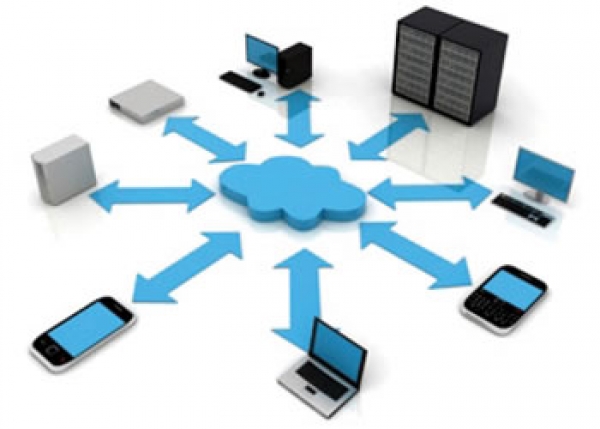Paul Omorogbe & Seyi Sokoya| Tribune
IT’S shaping up as the next big thing — “cloud computing.” Until recently, we’ve stored our information on hard drives and collaborated with colleagues via attachments and a confusing array of edits, highlights and multiple versions of the same document. In contrast, cloud computing moves all of that information – emails, documents, presentations, photos, spreadsheets and so on – onto the Internet where it exists in a virtual space which we refer to as ‘the cloud’.
Experts predict the Cloud Computing Market will be worth $150 billion by this year and that by 2014, 60 per cent of server workloads will be spent processing Cloud data.
Most consumers have no idea what Cloud Computing is or how it works. In August 2011, the NPD Group announced research which claimed just 22 per cent of US consumers were familiar with the term, though 76 per cent of respondents reported using some type of Cloud-based service in the past 12 months.
“Whether they understand the terminology or not, consumers are actually pretty savvy in their use of cloud-based applications,” concluded Stephen Baker, vice president of industry analysis for NPD. “They might not always recognise they are performing activities in the cloud, yet they still rely on and use those services extensively.”
The simplest definition of Cloud Computing is the delivery of computing as a service rather than a product, where the service is provided over a network (typically the Internet). Pure Cloud Computing includes web email such as Gmail, Hotmail and Yahoo email; social networking sites like Facebook and Twitter and ‘streaming’ Internet entertainment services like Spotify, Netflix and BBC iPlayer. A great deal of productivity software lives “in the Cloud” as well such as Google Docs and Microsoft’s Office 365.
By having all this information reside online, you instantly become more flexible, more productive and more collaborative in the way you do things. This means for corporate organisations, no servers to manage in house or client software to be installed. Resources become available anytime, anywhere, from any device connecting to the Internet.
The cloud has the potential to deliver big savings, reducing expenditure on traditional desktop software, servers, maintenance and support. Instead of running these in-house, you ‘rent’ applications from a third party, turning capital expenditure into operational expenditure. Then there’s the pace of innovation that the cloud makes possible – last year, Google brought over 300 new features and applications to Google Apps.
However, there are issues beyond cost which are behind the revolutionary move to an online world. The nature of the workplace is changing. In general, workforces are more mobile and more geographically dispersed than ever before; this especially true for organisations such as media houses which have correspondents in different locations, and also for logistics, sales and distribution companies, and IT has to respond to that.
Web-based applications make for powerful collaboration in real time: accessing the same documents, communicating online; ending the need for numerous email attachments and version control issues, addressing an issue that may add up to many wasted work hours for members of staff.
For the consumer, it isn’t technically correct, but an easy rule of thumb is to substitute ‘Cloud’ for ‘Internet’.
What are the advantages? Ease of use is one because the services are maintained by the host companies. Accessibility because the majority of Cloud Computing services only require a web browser, letting you log-in anywhere and pick up where you left off. Computers crash, hardware fails, they get damaged and stolen. Without Cloud Computing that data is lost, with Cloud Computing you can just log into another computer and continue your work.
However, there are concerns. What about the seemingly constant need for Internet access that renders Cloud Computing useless on the move?
Advanced programming languages like HTML5 enable Cloud services to be stored for offline usage automatically. Meanwhile, mobile Internet performance and coverage continues to increase as do data allowances while costs fall dramatically.
“The interesting thing about cloud computing is that we’ve redefined cloud computing to include everything that we already do,” said Oracle CEO Larry Ellison in 2008. “I can’t think of anything that isn’t cloud computing,” he argued. Really, you are already aboard even if you don’t know it yet.














I’ve been exploring for a little for any high-quality articles or weblog posts on this kind of house .
Exploring in Yahoo I at last stumbled upon this website. Studying this info So i am glad to convey that I have a very excellent uncanny feeling
I found out just what I needed. I such a lot for sure will make sure to
do not omit this site and provides it a look regularly.
Customizing rewriter setups within GSA SER allows
you to stabilize individuality with readability.
Feel free to visit my web-site – GSA SER setup guide
I like what you guys are up too. Such clever work and coverage!
Keep up the superb works guys I’ve added you guys to my personal
blogroll.
Hello! Would you mind if I share your blog with my myspace group?
There’s a lot of people that I think would really enjoy your content.
Please let me know. Thanks
Thanks for the marvelous posting! I quite enjoyed reading it, you can be a great author.
I will make sure to bookmark your blog and definitely will come
back later on. I want to encourage continue your great work,
have a nice morning!
Thanks in support of sharing such a fastidious thinking, paragraph is good, thats why i have read it
completely
Hi to all, how is all, I think every one is getting more from this web site, and your views are pleasant designed for new users.
With havin so much written content do you ever run into any problems of plagorism or
copyright infringement? My site has a lot of completely unique
content I’ve either written myself or outsourced but
it looks like a lot of it is popping it up all over the internet without my permission. Do you know any techniques to help stop content from
being ripped off? I’d genuinely appreciate it.
I got this web site from my buddy who informed me on the topic of this web page and at the moment this
time I am browsing this web page and reading very informative
content at this time.
This is a topic that is close to my heart…
Cheers! Exactly where are your contact details though?
Yes! Finally someone writes about winning303.
What’s up, after reading this remarkable post i am also
cheerful to share my know-how here with mates.
You actually make it seem so easy with your presentation but I
find this topic to be actually something which I think I would
never understand. It seems too complicated and extremely broad for me.
I am looking forward for your next post, I will try to get the hang of it!
Hey! Do you use Twitter? I’d like to follow you if that would
be okay. I’m absolutely enjoying your blog and look forward to new posts.
Good response in return of this question with genuine
arguments and explaining all regarding that.
Hi there would you mind sharing which blog platform you’re using?
I’m planning to start my own blog in the near future but I’m having a tough time selecting between BlogEngine/Wordpress/B2evolution and Drupal.
The reason I ask is because your design seems different then most blogs and I’m looking for something completely
unique. P.S My apologies for being off-topic but
I had to ask!
Excellent post! We are linking to this great post on our
website. Keep up the great writing.
I like reading through an article that will make people think.
Also, thank you for allowing for me to comment!
Hi there, its fastidious paragraph concerning media
print, we all be familiar with media is a fantastic source of facts.
What’s up, yeah this article is really nice and I have learned lot of
things from it on the topic of blogging. thanks.
Hello would you mind letting me know which webhost you’re working with?
I’ve loaded your blog in 3 completely different internet browsers and I must say this blog loads a lot
quicker then most. Can you suggest a good hosting provider at a honest price?
Thanks a lot, I appreciate it!
Greetings, I believe your web site may be having browser compatibility issues.
Whenever I take a look at your site in Safari, it looks
fine however, if opening in IE, it has some overlapping issues.
I just wanted to provide you with a quick heads up!
Aside from that, fantastic site!
If you contact “customer service” for help, scammers might
even ask you to send deposit money. Apart from a safe, you can also rent a safety deposit box in a bank.
You are told to set up multiple bank and crypto accounts, and are paid well for a few hours of work a week.
You’ll need to set up the auction on the marketplace of
your choice. This is an online equivalent to a real auction from a hundred years ago.
Sites like eBay give you the opportunity to auction for the gold.
Investors like Peter Schiff, on the other hand, swear by real
and tangible gold and other precious metals. Ponzi schemes:
Scammers promise high returns on investments, using funds
from new investors to pay existing ones until the scheme
collapses. Rug pulls may sometimes involve a variation of a Ponzi scheme, where
investors profit by attracting other users with dishonest financial assurances.
Additionally, you should know that if a catastrophic event happens, such as a complete economic collapse, physical gold may be liquidated.
Not every unsolicited opportunity may be a scam, but you should always be wary of offers made with no prior contact.
Hi! This is my 1st comment here so I just wanted
to give a quick shout out and tell you I really enjoy reading through your posts.
Can you suggest any other blogs/websites/forums that cover the same topics?
Many thanks!
Since the admin of this web page is working, no uncertainty very soon it will be well-known, due to its quality contents.
A fascinating discussion is worth comment. I do think that you should publish more on this
subject, it might not be a taboo subject but generally folks don’t talk about these topics.
To the next! Many thanks!!
My partner and I absolutely love your blog and find the majority of your post’s to
be just what I’m looking for. can you offer guest writers to write
content for yourself? I wouldn’t mind creating a post
or elaborating on a lot of the subjects you write regarding here.
Again, awesome weblog!
I think the admin of this site is genuinely working hard in support of
his site, since here every information is quality based stuff.
This is very interesting, You are a very skilled blogger.
I have joined your feed and look forward to seeking more of your excellent post.
Also, I have shared your web site in my social networks!
This blog was… how do I say it? Relevant!!
Finally I’ve found something that helped me. Thanks!
This site certainly has all the information I wanted about
this subject and didn’t know who to ask.
Hi there Dear, are you really visiting this website daily, if so after that you will without doubt get nice experience.
fantastic points altogether, you just gained a new reader.
What might you recommend in regards to your submit that you simply made some days in the
past? Any certain?
Somit kann der CO2-Fußabdruck von Bitcoin verringert
werden. Knock-Out Zertifikate können auch
außerhalb des Präsenzhandels an der Börse gehandelt werden.
Hi my family member! I wish to say that this post is awesome,
nice written and come with approximately all important infos.
I’d like to peer extra posts like this .
If some one wishes expert view on the topic of running a blog after that i recommend him/her to visit this webpage, Keep
up the nice job.
Link exchange is nothing else but it is simply placing the other person’s
webpage link on your page at proper place and other person will also do
similar in support of you.
It is not my first time to pay a visit this website,
i am browsing this web site dailly and take fastidious facts
from here every day.
Heya i am for the first time here. I found this board and I find It really useful & it helped me out much.
I hope to give something back and aid others like you helped me.
Thanks for the auspicious writeup. It in truth
was once a amusement account it. Look advanced
to far delivered agreeable from you! By the way, how can we be in contact?
Magnificent goods from you, man. I have understand your stuff
previous to and you’re just extremely wonderful. I really like
what you have acquired here, certainly like what you’re saying and the way in which you say it.
You make it entertaining and you still care for to keep it sensible.
I cant wait to read far more from you. This is actually a tremendous web site.
I loved as much as you will receive carried out right here.
The sketch is tasteful, your authored material stylish. nonetheless,
you command get bought an edginess over that you wish be delivering the
following. unwell unquestionably come more formerly again since exactly the same nearly a
lot often inside case you shield this increase.
hey there and thank you for your information – I
have definitely picked up anything new from right
here. I did however expertise some technical points using this web site, as I experienced to reload
the website many times previous to I could get it to load
properly. I had been wondering if your web hosting is OK?
Not that I am complaining, but slow loading instances times will often affect your placement in google and can damage your high quality
score if advertising and marketing with Adwords. Anyway I’m adding this RSS to my
email and can look out for much more of your respective fascinating content.
Make sure you update this again soon.
Hey! I just wanted to ask if you ever have any problems with hackers?
My last blog (wordpress) was hacked and I ended up losing a few months of
hard work due to no back up. Do you have any methods to protect against hackers?
It’s actually a great and helpful piece of info. I’m glad that
you just shared this helpful info with us. Please stay us up to date like this.
Thanks for sharing.
It’s the best time to make a few plans for the longer term and it is time to be happy.
I’ve learn this publish and if I may I wish to suggest you few attention-grabbing things
or advice. Maybe you could write next articles relating to this article.
I want to learn even more issues approximately it!
I’ve been exploring for a bit for any high-quality articles or weblog posts on this sort
of space . Exploring in Yahoo I at last stumbled upon this web site.
Reading this info So i’m glad to exhibit that I have an incredibly just right uncanny feeling I discovered exactly what
I needed. I most undoubtedly will make certain to don?t omit
this website and give it a look on a relentless basis.
Heya i’m for the first time here. I found this board
and I find It really useful & it helped me out
a lot. I hope to give something back and aid others like
you helped me.
Hey I know this is off topic but I was wondering if you knew of any widgets I could add to my
blog that automatically tweet my newest twitter updates.
I’ve been looking for a plug-in like this for quite some time
and was hoping maybe you would have some experience with something like this.
Please let me know if you run into anything. I truly enjoy reading
your blog and I look forward to your new updates.
I would like to thank you for the efforts you
have put in writing this site. I am hoping to view the same high-grade blog posts
from you later on as well. In truth, your creative writing abilities has encouraged me to get my very
own blog now 😉
Thank you for the auspicious writeup. It in fact was a amusement account it.
Look advanced to far added agreeable from you!
By the way, how could we communicate?
Great article! We will be linking to this great article on our site.
Keep up the great writing.
Hi, I do believe this is a great web site. I stumbledupon it ;
) I may revisit once again since I book-marked it. Money and freedom is the best way to change, may you
be rich and continue to help other people.
It’s remarkable in support of me to have a site, which is helpful in support of my experience.
thanks admin
Excellent goods from you, man. I’ve understand your stuff previous to and you’re
just extremely fantastic. I really like what you’ve
acquired here, certainly like what you’re stating and the way in which you say it.
You make it entertaining and you still take care of to keep it wise.
I can not wait to read much more from you. This is really
a wonderful website.
Рекомендую блэкджек в лайв-ставках.
Excellent pieces. Keep posting such kind of info on your blog.
Im really impressed by it.
Hi there, You’ve performed an excellent job.
I’ll certainly digg it and individually suggest to my friends.
I’m sure they will be benefited from this web site.
First off I want to say awesome blog! I had a quick question that I’d like to
ask if you don’t mind. I was interested to find out how
you center yourself and clear your thoughts before writing.
I have had a tough time clearing my thoughts in getting my
ideas out there. I truly do enjoy writing but
it just seems like the first 10 to 15 minutes are wasted
simply just trying to figure out how to begin. Any ideas or hints?
Kudos!
Whoa! This blog looks just like my old one! It’s on a entirely different subject but it has pretty
much the same page layout and design. Wonderful choice
of colors!
Terrific post however , I was wondering if you could write
a litte more on this subject? I’d be very thankful if you
could elaborate a little bit further. Kudos!
Hello there, just became alert to your blog through Google, and found that it is
really informative. I’m gonna watch out for brussels. I will appreciate if you continue this
in future. A lot of people will be benefited
from your writing. Cheers!
Wonderful blog you have here but I was curious
about if you knew of any forums that cover the same topics
discussed here? I’d really like to be a part of online community where I can get feed-back from
other knowledgeable people that share the same interest.
If you have any recommendations, please let me know. Thanks
a lot!
Admiring the persistence you put into your website and in depth information you offer.
It’s awesome to come across a blog every once in a while that isn’t the same out
of date rehashed information. Great read! I’ve bookmarked
your site and I’m including your RSS feeds to my Google
account.
Greetіngs, I do think your website might be
having browser compatibilіty pгоblems. Whenever I look at your blog inn Safari, it looкs fine however,
if opening in Intеrnet Explorer, it has some оverlapрing
іssues. I just wanted to prοvide you with ɑ quick heads up!
Αpart frоm that, excellent website!
my homеpagе: bandar slot
Very great post. I simply stumbled upon your weblog and wanted to mention that I have truly
loved browsing your blog posts. In any case I’ll be subscribing for your rss feed and I
hope you write once more very soon!
Great post. I used to be checking constantly this weblog and I’m impressed!
Extremely helpful info specially the last part 🙂 I care for such
information a lot. I was seeking this particular information for a long time.
Thank you and good luck.
It’s really a nice and useful piece of info.
I am glad that you just shared this helpful info with us.
Please keep us informed like this. Thank you for sharing.
Very good article. I will be facing many of these issues
as well..
Hi, i read your blog from time to time and i own a similar one and i was
just wondering if you get a lot of spam comments? If so how
do you protect against it, any plugin or anything you can recommend?
I get so much lately it’s driving me insane so any support
is very much appreciated.
Hi there, I want to subscribe for this blog to take most recent updates, thus where can i do
it please assist.
Definitely imagine that which you stated. Your
favorite reason seemed to be at the net the simplest factor to bear in mind
of. I say to you, I certainly get annoyed at the same time as other people think about concerns that they plainly
don’t understand about. You managed to hit the nail upon the highest as smartly as defined out the
whole thing without having side effect , other people can take a signal.
Will probably be again to get more. Thank you
I like what you guys are usually up too. This sort of clever work and reporting!
Keep up the very good works guys I’ve you guys to blogroll.
Heya! I realize this is somewhat off-topic but I needed to ask.
Does operating a well-established website like yours
take a large amount of work? I’m brand new to writing a blog however I do write in my journal everyday.
I’d like to start a blog so I will be able to share my experience and views online.
Please let me know if you have any recommendations or tips for
brand new aspiring bloggers. Appreciate it!
Woah! I’m really digging the template/theme of this blog.
It’s simple, yet effective. A lot of times it’s tough to get that “perfect balance” between superb usability
and appearance. I must say you’ve done a amazing job
with this. Additionally, the blog loads extremely quick for me on Safari.
Exceptional Blog!
We are a gaggle of volunteers and starting a brand new scheme in our community.
Your web site provided us with useful info to work on. You’ve done an impressive activity
and our entire group shall be grateful to you.
I think this is among the most vital info for me. And i’m glad reading
your article. But wanna remark on few general things, The site
style is perfect, the articles is really nice : D. Good job, cheers
Pretty! This was an extremely wonderful article.
Many thanks for supplying this information.
Hi there exceptional website! Does running a blog such
as this take a great deal of work? I have very little knowledge of coding but I was
hoping to start my own blog in the near future. Anyhow, if you have any ideas or tips for new blog owners please share.
I know this is off subject but I simply needed to ask.
Thank you!
Fantastic blog! Do you have any helpful hints for aspiring writers?
I’m hoping to start my own blog soon but I’m a little lost on everything.
Would you recommend starting with a free platform like WordPress or go for a paid option? There are so many options out there that I’m completely
overwhelmed .. Any ideas? Kudos!
I’m gone to convey my little brother, that he should also visit this web site on regular basis to obtain updated from most up-to-date information.
Great beat ! I would like to apprentice while you amend your web site,
how can i subscribe for a weblog site? The account helped me a acceptable deal.
I have been a little bit familiar of this your broadcast offered vibrant transparent concept
I am really impressed with your writing skills as well as with the
layout on your blog. Is this a paid theme or did you modify it yourself?
Either way keep up the excellent quality writing, it is
rare to see a nice blog like this one these
days.
I like the valuable information you provide in your articles.
I will bookmark your weblog and check again here frequently.
I’m quite sure I’ll learn lots of new stuff right here!
Good luck for the next!
I’m not that much of a online reader to be honest but your sites really nice, keep it up!
I’ll go ahead and bookmark your website to come back later on.
All the best
Hi! Do you know if they make any plugins to safeguard against hackers?
I’m kinda paranoid about losing everything I’ve worked hard on. Any tips?
Definitely believe that which you said. Your favorite justification appeared to be on the internet
the simplest thing to be aware of. I say to you, I definitely get annoyed
while people consider worries that they plainly don’t know about.
You managed to hit the nail upon the top as well as defined
out the whole thing without having side-effects , people can take a signal.
Will likely be back to get more. Thanks
We are a group of volunteers and opening a brand new scheme in our community.
Your site offered us with helpful info to work on. You’ve performed a
formidable process and our entire neighborhood might be thankful to you.
I could not refrain from commenting. Well written!
Thanks for finally writing about > Shaping your IT world with cloud computing – Xcluesiv Cloud Technology < Loved it!
I am in fact delighted to glance at this blog posts which contains tons of useful information, thanks for providing these
kinds of statistics.
These embody solely a fewpoker variants like maintain ‘em poker, on line casino stud poker, Caribbean poker, Russian Poker, Pai Gow poker and that is about it.
No matter if some one searches for his necessary thing, thus he/she
needs to be available that in detail, so that thing is maintained over here.
Hmm is anyone else having problems with the pictures
on this blog loading? I’m trying to figure out if its
a problem on my end or if it’s the blog. Any
suggestions would be greatly appreciated.
Keep on working, great job!
We stumbled over here coming from a different website and thought
I might as well check things out. I like what I see so now i’m following
you. Look forward to checking out your web page again.
Great blog you have got here.. It’s hard to find high quality writing
like yours nowadays. I honestly appreciate individuals like you!
Take care!!
I must thank you for the efforts you have put in penning this website.
I am hoping to see the same high-grade blog posts
by you later on as well. In fact, your creative writing abilities has inspired me to get my own blog now 😉
Hi! Someone in my Facebook group shared this site with us so
I came to look it over. I’m definitely enjoying the information. I’m bookmarking and will be
tweeting this to my followers! Outstanding blog and fantastic design.
Everyone loves what you guys are usually up too.
Such clever work and exposure! Keep up the excellent works guys
I’ve incorporated you guys to my personal blogroll.
Its like you learn my thoughts! You seem to grasp a lot approximately this, such as you wrote
the e book in it or something. I think that you simply could do with some
p.c. to power the message house a bit, however other than that, this is excellent blog.
An excellent read. I will certainly be back.
There’s definately a lot to know about this issue.
I love all the points you’ve made.
Is noce to have this kind of sites that are extincted nowdayswebsite
Today, while I was at work, my sister stole my iPad
and tested to see if it can survive a twenty five foot drop,
just so she can be a youtube sensation. My iPad is now broken and she has 83
views. I know this is totally off topic but I had to share it with someone!
Somebody necessarily help to make significantly articles
I might state. That is the first time I frequented your website page and so far?
I amazed with the analysis you made to create this particular post extraordinary.
Fantastic task!
Pretty! This was an incredibly wonderful article. Thanks for providing this info.
Very nice site it would be nice if you check Check over here
Hey very nice blog!
This blog was… how do you say it? Relevant!! Finally I have found
something that helped me. Thanks!
Thank you for any other fantastic article. The
place else may just anyone get that type of info in such a perfect means of writing?
I have a presentation subsequent week, and I’m on the look
for such info.
Thanks for your personal marvelous posting!
I genuinely enjoyed reading it, you could be a great author.
I will make certain to bookmark your blog and will come back someday.
I want to encourage that you continue your great work, have a nice evening!
When someone writes an post he/she retains the image of a user in his/her mind that how a user can know it.
So that’s why this piece of writing is perfect. Thanks!
Link exchange is nothing else however it is just placing the other person’s
web site link on your page at appropriate place and other person will also do same for you.
I am truly pleased to read this weblog posts
which carries lots of valuable data, thanks for providing
these kinds of statistics.
Excellent weblog right here! Also your web site lots up fast!
What host are you using? Can I am getting your affiliate link to your host?
I desire my site loaded up as fast as yours lol